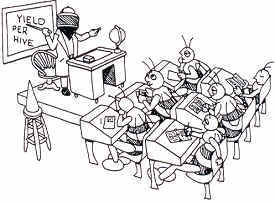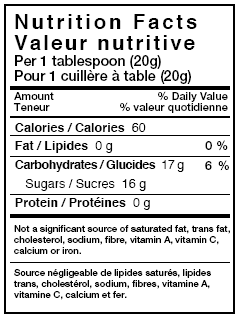How
is honey made?

The
raw material for honey is nectar from flowers.
Honey bees collect this nectar, bring it back to the hive, and make it
into honey. Once in the hive, bees change the chemical structure of the nectar
into honey. The bees begin to fan
the honey to a desired moisture content. Finally
a wax capping is placed over the full cells of honey to help preserve it.
Is
making honey hard work?
Well,
it’s not easy. Honey is
"manufactured" in one of the world's most efficient, state-of-the-art food
processing factory, the beehive. Bees may travel a combined distance of 55,000
miles and visit more than two million flowers to gather enough nectar to make a
single pound of honey. All in a
days work.
Is
all honey the same?
There
are over 450 plants in the world that produce surplus nectar, and the honey that
bees produce from each species has remarkable differences in color, taste and
smell. Luckily, different plant species tend to flower at different times of the
year. Also, beekeepers place their hives in the middle of a mostly one plant
species floral source, that is blooming during a particular season for the
"honey flow". After the "honey flow" of one floral source has been collected, the
beekeeper moves his/her hives to another floral source and collects a honey of a
different floral source.
What
is raw honey?
Raw
honey is honey that has not been over-heated or over-strained. Excess heating,
such as used to produce liquid honey, destroys the natural enzymes and vitamin
rich floral pollens.
What's
so good about bee pollen?
Although
there are numerous testimonies of people who have overcome their allergies by
taking bee pollen, many people don't realize that bee pollen is also a potent
natural source of vitamins and nutrients. It is very high in vitamin B and C and
contains every other vitamin except D and K. It is also rich in iron, calcium,
and zinc.
What
is pasteurized honey?
Granulation
or crystallization (the growth of glucose crystals) is a natural process in all
honey. Darker honey seem to crystallize faster than lighter colored honey. In
grocery stores you will find most likely liquid honey that has been heated to
very high temperatures (to kill yeast spores), filtered very finely (to remove
starter crystals), and even had its moisture level increased artificially. The
honey may look like it has just come out of the hive, but in reality it has been
highly processed. The only advantage of this type of processed, pasteurized
honey, is that is does not crystallize for a long time while waiting for a
customer on the store shelf.
Is
honey the same as sugar?
If
by "sugar" we mean white table sugar, the answer is definitely no.
Table sugar is sucrose, a substance made up of two molecules attached together.
When we eat table sugar, our stomach has to use its own enzymes to separate the
molecules apart before we can use the sugar's energy. Honey is quite different.
The bees have added a special enzyme to the nectar that separates the sucrose
into glucose and fructose, two simple sugars that our bodies can directly
absorb. In effect, the bees have
already "pre-digested" the sugar in honey for us, so it is an instant
source of food energy and easier on our stomachs to digest.
How
should honey be stored?
Store
honey at room temperature. Refrigeration speeds up crystallization. If honey
crystallizes, remove lid and place the container in warm water. Or, microwave 1
cup of honey in microwave-safe container for 2-3 minutes or until crystals
dissolve, stir every 30 seconds.
Be careful not to cook the honey during microwaving as this high heat can
discolor, create an off taste, and even destroy the nutritional goodness of
honey.
Can
honey spoil?
One
reason honey is called a "miracle food" is because in its natural form,
it is fully preserved. No organisms can live in it and the product will not
decompose. However, if the moisture content is raised above 20%, yeasts can
begin to grow and cause fermentation. Honey can also change texture over time,
and separate out into a solid (glucose) and liquids (fructose and moisture).
Stirring the product will mix up the components and return it to its former
granulated state.
How
nutritious is honey?
Common
table sugar is 99% sucrose. Honey, on the other hand, is composed of glucose,
fructose and vitamins, minerals, enzymes, antioxidants and oligosaccharides.
Although relatively low in nutrients compared to some other foods, honey
contains more nutrients than table sugar. For nutrients, the highest level in
honey is iron followed by vitamin B6, phosphorus, copper, vitamin C, vitamin B2,
zinc, magnesium, and calcium.
Is
there other uses for honey?
Honey
has been credited for centuries for it's sweet and medicinal applications.
External applications include the treatment of wounds, cuts, burns, and acne.
Internal uses for honey include stomach and duodenal ulcers.
Why babies and children two years and younger are NOT allowed to have honey?
Pediatricians
recommend that honey should not be fed to babies and children under the age of
two years, because of the possibility that Clostridium Botulinum spores (the
cause of infant botulism) could be present in honey. Spores of this bacteria do
not germinate in the acidic adult digestive system, but may grow in the gut of
young infants because they do not have a well-developed intestinal system.
However, cases of infant botulism are extremely rare, but this form of
food poisoning can seriously affect the nervous system of babies.
Important to note, spores of the disease can also be present in the soil
and in a range of common foods, especially raw foods.
Can
diabetics use honey?
Clinical
studies have shown that honey is a better food for diabetics than sugar.
Honey has lower required insulin levels compared to other foods and produces
lower rises in blood sugar due to the fructose it contains. However, diabetics
should always consult their doctor before including honey in their diet.
Did
you also know…
After
30 years in the business, we have collected some cool trivia for you.
q
Bees fly an
average of 15 miles per hour.
q
During the honey gather season a
worker bee's average life span is six weeks.
q
Bees consume 8 pounds of honey
just to produce 1 pound of beeswax.
q
The bee’s "buzz" is the
sound of their wings beating 11,000 times per minute.
q
Queens will lay approximately
2,000 eggs per day.
q
There are 40,000 to 60,000 bees
in a beehive during honey-gathering season.
q
Honey has been used to treat
wounds since bacteria cannot live in it.
q
Fermented honey, known as mead,
is the most ancient fermented beverage.
q
The term "honey moon"
originated with the Norse practice of consuming large quantities of mead during
the first month of a marriage.
q
Honeybees
are the only insects that produce food for humans.
|